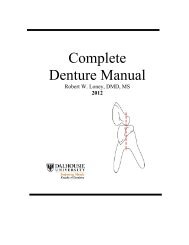RPD Manual 11 - Removable Prosthodontics - Dalhousie University
RPD Manual 11 - Removable Prosthodontics - Dalhousie University
RPD Manual 11 - Removable Prosthodontics - Dalhousie University
Create successful ePaper yourself
Turn your PDF publications into a flip-book with our unique Google optimized e-Paper software.
Minor Connectors - 38<br />
Definition<br />
Minor Connectors<br />
A unit of a partial denture which connects other components (e.g. direct retainer, indirect<br />
retainer, denture base, etc.) to the major connector.<br />
Functions<br />
1. Provide unification and rigidity<br />
2. Provide stress distribution by transferring stresses from the major connector to other parts<br />
of the partial denture and from the partial denture to the abutment teeth<br />
3. Act as bracing elements through contact with guiding planes opposing the retentive arms.<br />
4. Maintain a path of insertion via contact with guiding planes<br />
Basic Types of Minor Connectors:<br />
a. Minor connectors placed into embrasures between two adjacent teeth. These<br />
connectors should be somewhat triangular shaped in cross section to minimize intrusion<br />
into the tongue or vestibular spaces, while still providing adequate bulk for rigidity (a). A<br />
minor connector should join the major connector at a right angle and cover as small an area<br />
of tissue as possible (b). The juncture to the major connector should be rounded (arrow)<br />
not sharp (X) unless the juncture includes an acrylic finish line. Relief should be placed on<br />
the master cast so that the minor connector does not lie directly on the soft tissue (c).<br />
A minor connector should fill the embrasure space so that a smooth surface is presented to<br />
the tongue and so that areas where food can be trapped are minimized. Ideally, a minor<br />
connector should not contact the teeth gingival to the height of contour. If a minor<br />
connector fits tightly against an abutment below the height of contour, a wedging force<br />
may be created during functional movements of the framework. This wedging can result in<br />
increased tooth mobility. Alternatively, it may be difficult to seat or unseat the framework.<br />
b. Gridwork minor connectors that connect the denture base and teeth to the major<br />
connector. These minor connectors are adjacent edentulous spaces and usually connect<br />
the major connector to a clasp assembly as well. Gridworks can be an open lattice work or<br />
mesh type. The mesh type tends to be flatter, with more potential rigidity. Conversely the<br />
mesh has been shown provide less retention for the acrylic if the openings are insufficiently<br />
large. The lattice type has superior retentive potential, but can interfere with the setting of<br />
teeth, if the struts are made too thick or poorly positioned. Both types are acceptable if<br />
correctly designed.















